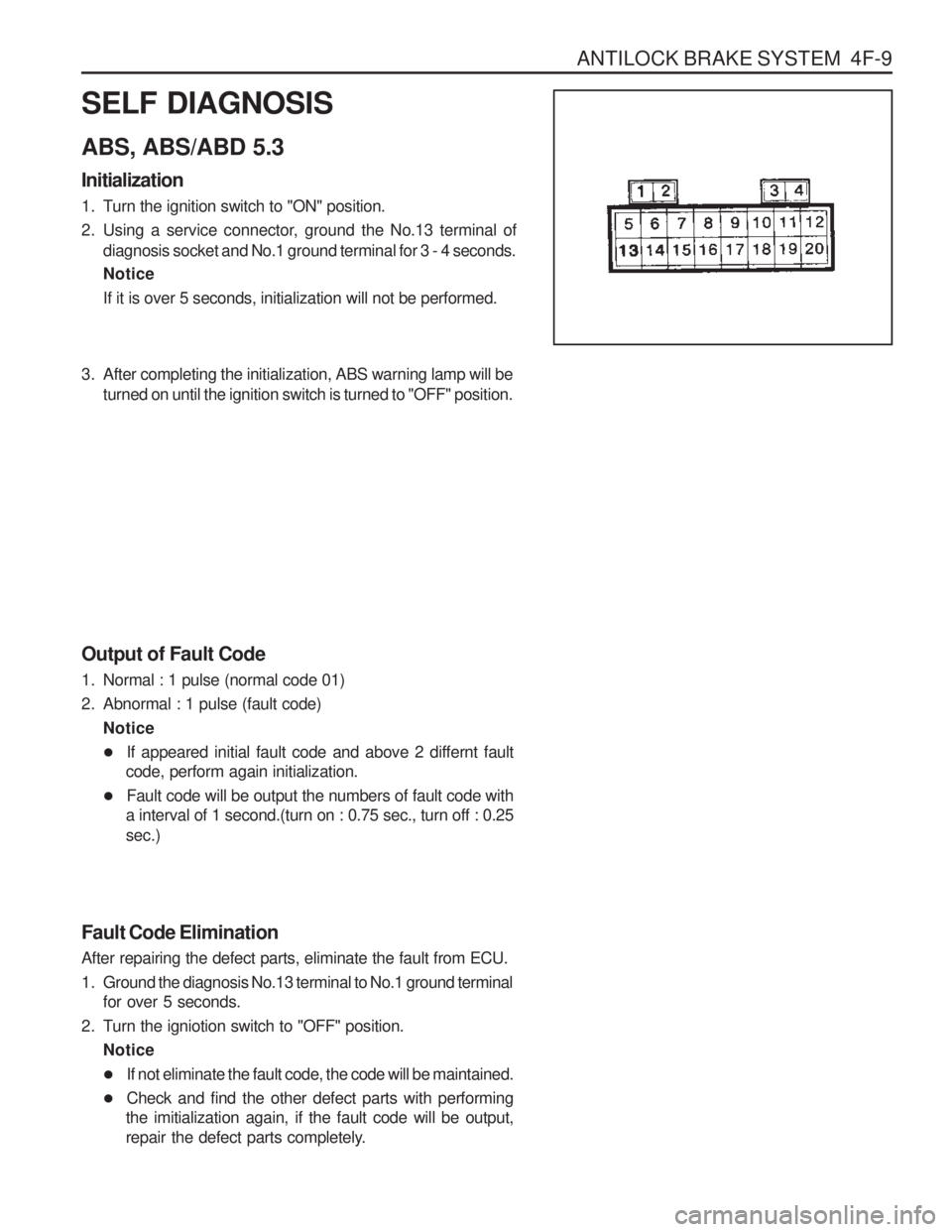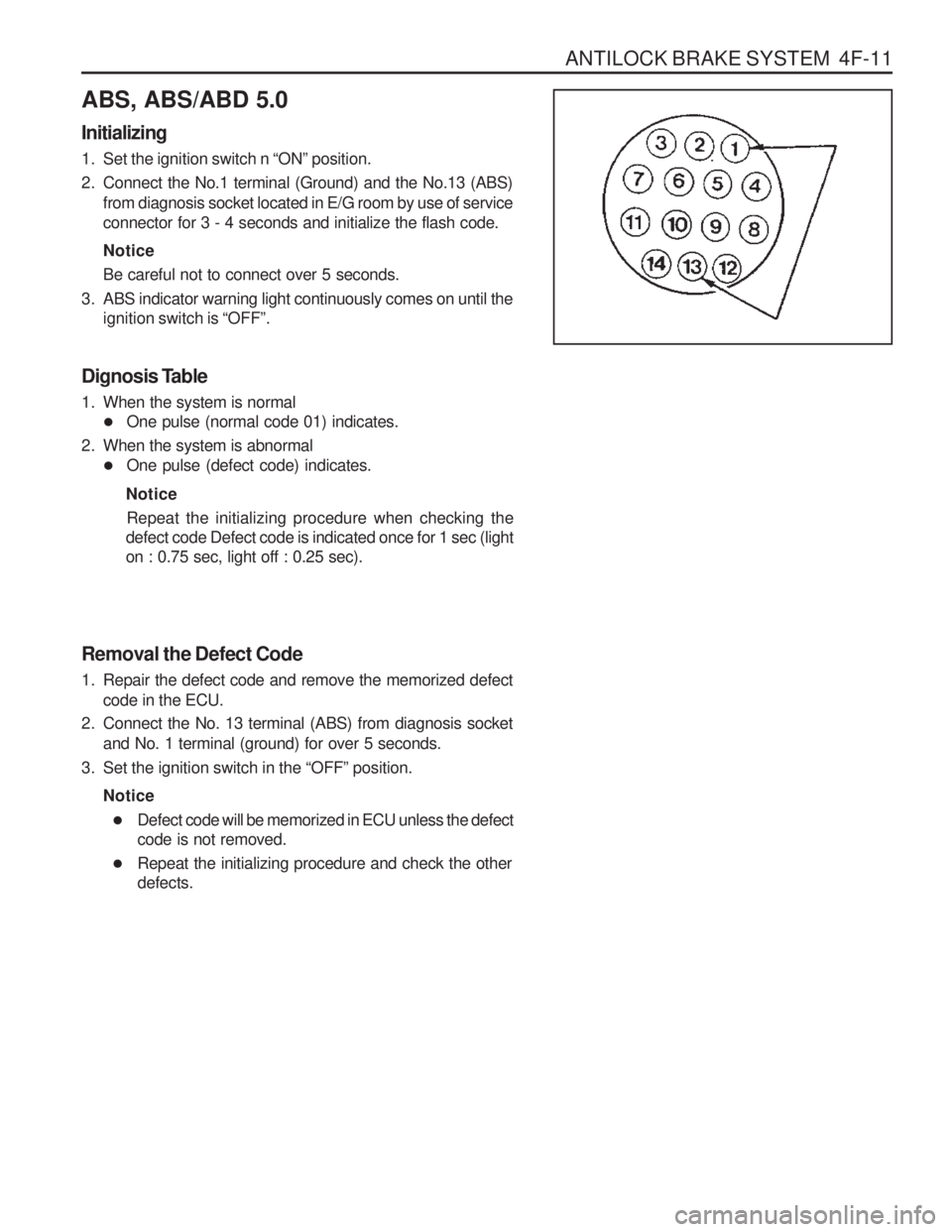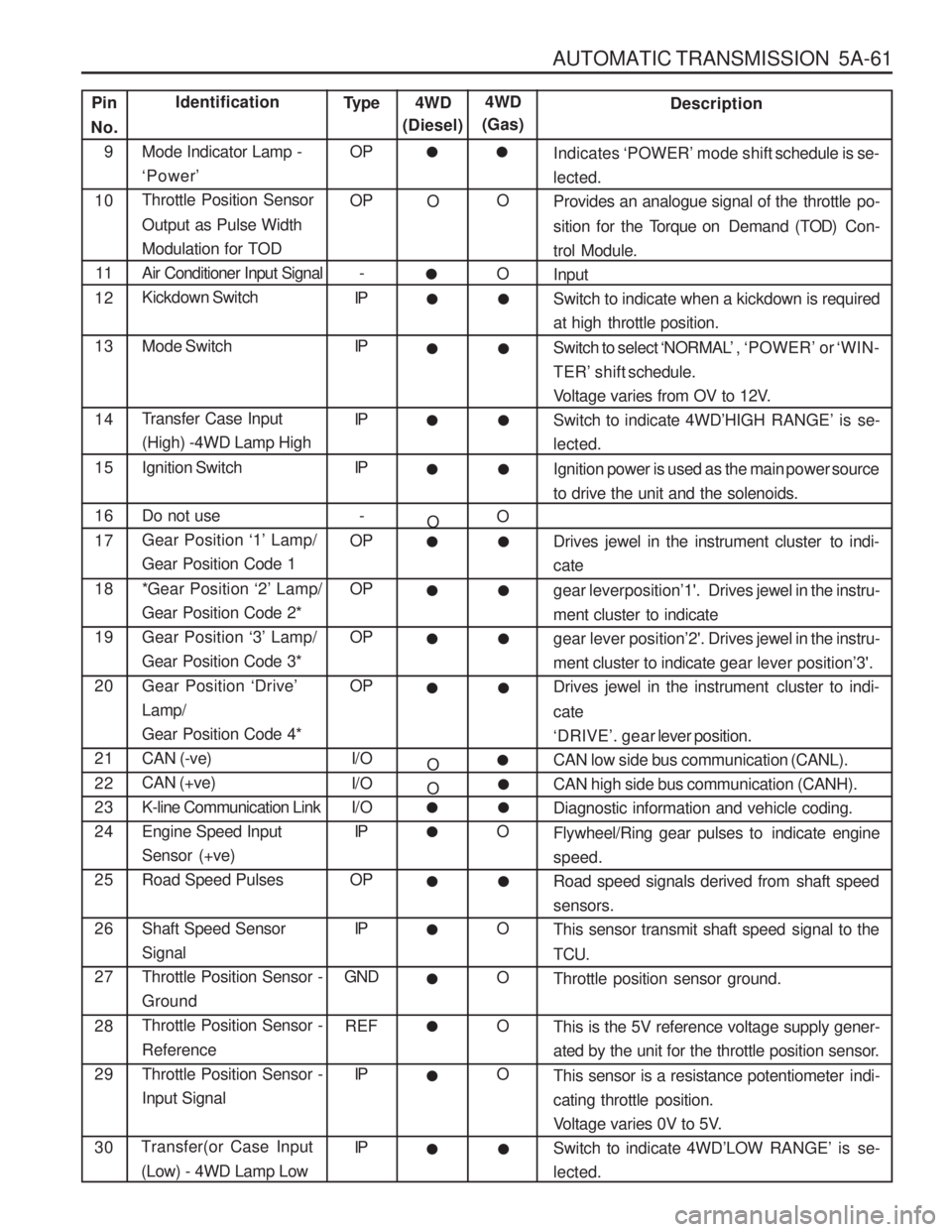2003 SSANGYONG MUSSO ignition
[x] Cancel search: ignitionPage 837 of 1574

4F-8 ANTILOCK BRAKE SYSTEM
Temperature Model:ABD operation is a high thermal load for the brakes.
To avoid any damages at the brakes, the disk temperature is calculated with a mathematical model for each driven
wheel separately. After ignition on, the calculation starts with 30 °C and then three different phases are evaluated
separately and added: ABD operation, braking and coling phase.If the temperature is highter than 500 °C, ABD is disabled for this wheel.
It is permitted again, if the model has calculated down the 350 °C.
Lamp Concepts: The system is equipped with an ABD information lamp, which is blinking during ABD operation.The activation of the EBD, ABS warning lamp and the ABD info lampo is summarized in the following table:
IgnitionON ABS
Operation ABD
Operation System failure
(EBD,ABS or ABD are
not distinguished) ABD passive due
to temperature
model
ABS warning lamp
ABD info lamp
EBD warning lamp 2s on for lamp
check
2s on for lamp check
2s on for lamp check OFF
EBD operation / OFFOFF
OFF
Dlinking
(Flashing)
OFF ON
OFF ON OFF OFF OFF
Page 838 of 1574

ANTILOCK BRAKE SYSTEM 4F-9
SELF DIAGNOSIS ABS, ABS/ABD 5.3 Initialization
1. Turn the ignition switch to "ON" position.
2. Using a service connector, ground the No.13 terminal ofdiagnosis socket and No.1 ground terminal for 3 - 4 seconds. Notice If it is over 5 seconds, initialization will not be performed.
3. After completing the initialization, ABS warning lamp will beturned on until the ignition switch is turned to "OFF" position.
Output of Fault Code
1. Normal : 1 pulse (normal code 01)
2. Abnormal : 1 pulse (fault code) Notice
� If appeared initial fault code and above 2 differnt fault
code, perform again initialization.
� Fault code will be output the numbers of fault code with
a interval of 1 second.(turn on : 0.75 sec., turn off : 0.25 sec.)
Fault Code Elimination After repairing the defect parts, eliminate the fault from ECU.
1. Ground the diagnosis No.13 terminal to No.1 ground terminal for over 5 seconds.
2. Turn the igniotion switch to "OFF" position. Notice
� If not eliminate the fault code, the code will be maintained.
� Check and find the other defect parts with performing
the imitialization again, if the fault code will be output,
repair the defect parts completely.
Page 840 of 1574

ANTILOCK BRAKE SYSTEM 4F-11
ABS, ABS/ABD 5.0 Initializing
1. Set the ignition switch n “ON ” position.
2. Connect the No.1 terminal (Ground) and the No.13 (ABS) from diagnosis socket located in E/G room by use of service connector for 3 - 4 seconds and initialize the flash code. Notice Be careful not to connect over 5 seconds.
3. ABS indicator warning light continuously comes on until the ignition switch is “OFF ”.
Dignosis Table
1. When the system is normal � One pulse (normal code 01) indicates.
2. When the system is abnormal � One pulse (defect code) indicates.
Notice Repeat the initializing procedure when checking the
defect code Defect code is indicated once for 1 sec (light on : 0.75 sec, light off : 0.25 sec).
Removal the Defect Code
1. Repair the defect code and remove the memorized defect code in the ECU.
2. Connect the No. 13 terminal (ABS) from diagnosis socket and No. 1 terminal (ground) for over 5 seconds.
3. Set the ignition switch in the “OFF ” position.
Notice � Defect code will be memorized in ECU unless the defect code is not removed.
� Repeat the initializing procedure and check the otherdefects.
Page 846 of 1574

ANTILOCK BRAKE SYSTEM 4F-17
Application
Power Voltage
Residual Temperature Measurement (ABD only) Acceleration Sensor Signal (wire)Defect Code
28 29 42Description
when switch knob (planger) is pressed by 3mm : �
- Each ends resistance value of the switch when switch knob(plunger) is not pressed : less than 200 m �
� When brake is applied :
ECU (ABS:No.14, ABD:No.48) terminal 11 - 14 V
or VBattery.When brake is released : ECU (ABS:No.14, ABD:No.48) terminal 0 V
� Check battery voltage.
� Resistance between ECU (ABD:No.28 & 29,
ABS:No.19) pins and battery negative terminal :
less than 20 m �
� Resistance between ECU No.1 (ABS:NO.15) pin and
ignition terminal : less than 60 m �
� Check that normal voltage is applied to ECU
(ABD:No.1, ABS:No.15) pin when ignition switch is turned to "ON" or "OFF".
� Check ABS fuses of 15A and 80A.
� Replace the ECU.
� Check wire (ECU No.50) for open or loose contact.
� Check connection between connectors.
� Check relevant wires for open or short.(When connector is removed)
� Check voltage between ECU side ground (ABD:No.1,
ABS:No.15 pin) and acceleration sensor side ground(ABD:No.1, ABS:No.15 pin / ECU side ABD:No.39, ABS:No.30 pin)
(When connector is installed and power is applied)
- Voltage : less than 0.25 V
� Check voltage among related terminals.(When connector is installed and power is applied)
- Voltage between ECU (ABD:No.43, ABS:No.28 pin
and ABD:No.39, ABS:No.30 pin) : 4.75 - 5.25 V
- Signal voltage between ECU (ABD:No.51, ABS:No.10) pin and (ABD:No.39, ABS:No.30) pin : 1.95 V - 3.45 V
(Measure it by laying acceleration sensor horizon- tally and without external force)
Page 856 of 1574

SECTION 4G
PARKING BRAKE
Specifications . . . . . . . . . . . . . . . . . . . . . . . . 4G-1General Specifications . . . . . . . . . . . . . . . . . . 4G-1
Fastener Tightening Specifications . . . . . . . . . 4G-1
Component Locator . . . . . . . . . . . . . . . . . . . 4G-2 TABLE OF CONTENTS
Parking Brake . . . . . . . . . . . . . . . . . . . . . . . . . 4G-2
Maintenance and Repair . . . . . . . . . . . . . . . 4G-3
On-Vehicle Service . . . . . . . . . . . . . . . . . . . . . 4G-3 Parking Brake . . . . . . . . . . . . . . . . . . . . . . . . . 4G-3
Caution: Disconnect the negative battery cable before removing or installing any electrical unit or when a tool or equipment could easily come in contact with exposed electrical terminals. Disconnecting thiscable will help prevent personal injury and damage to the vehicle. The ignition must also be in LOCKunless otherwise noted.
SPECIFICATIONS
GENERAL SPECIFICATIONS
Application
Parking Brake Lever Bolt Cable Mounting Bracket Bolt
N
m
8 - 18 8 - 18
FASTENER TIGHTENING SPECIFICATIONS
Application
Type
Operating Type
Description
Mechanically Operated Rear Wheel Expansion Manual
Page 920 of 1574

AUTOMATIC TRANSMISSION 5A-61
Pin
No. 9 10
11
12 13 14 1516 17 1819 20 21 22 2324 25 26 27 28 29 30Identification
Mode Indicator Lamp - ‘ Power ’
Throttle Position Sensor Output as Pulse Width Modulation for TODAir Conditioner Input SignalKickdown Switch Mode Switch
Transfer Case Input (High) -4WD Lamp High Ignition Switch Do not use Gear Position ‘1’ Lamp/
Gear Position Code 1
*Gear Position ‘2’ Lamp/
Gear Position Code 2* Gear Position ‘3’ Lamp/
Gear Position Code 3* Gear Position ‘Drive ’
Lamp/ Gear Position Code 4*CAN (-ve)CAN (+ve) K-line Communication Link Engine Speed InputSensor (+ve)Road Speed Pulses Shaft Speed Sensor SignalThrottle Position Sensor -GroundThrottle Position Sensor - Reference Throttle Position Sensor -Input Signal
Transfer(or Case Input
(Low) - 4WD Lamp Low Type
OP OP
-
IP IP IP IP
-
OPOPOP OP
I/O
I/O
I/O IP
OP
IP
GND
REF IP IP Description
Indicates ‘POWER ’ mode shift schedule is se-
lected.
Provides an analogue signal of the throttle po- sition for the T orque on Demand (T OD) Con-
trol Module. Input
Switch to indicate when a kickdown is required
at high throttle position. Switch to select ‘NORMAL ’, ‘POWER ’ or ‘WIN-
TER ’ shift schedule.
Voltage varies from OV to 12V. Switch to indicate 4WD ’HIGH RANGE ’ is se-
lected.
Ignition power is used as the main power source
to drive the unit and the solenoids.
Drives jewel in the instrument cluster to indi- cate gear leverposition ’1'. Drives jewel in the instru-
ment cluster to indicate gear lever position ’2'. Drives jewel in the instru-
ment cluster to indicate gear lever position’3'.
Drives jewel in the instrument cluster to indi- cate ‘ DRIVE ’. gear lever position.
CAN low side bus communication (CANL).
CAN high side bus communication (CANH).
Diagnostic information and vehicle coding.
Flywheel/Ring gear pulses to indicate engine speed.
Road speed signals derived from shaft speedsensors.
This sensor transmit shaft speed signal to the TCU. Throttle position sensor ground. This is the 5V reference voltage supply gener-
ated by the unit for the throttle position sensor.
This sensor is a resistance potentiometer indi-
cating throttle position.
Voltage varies 0V to 5V.Switch to indicate 4WD ’LOW RANGE ’ is se-
lected.
4WD
(Diesel)
O O O O
�
�
�
4WD
(Gas)
O O O O O O OO
�
�
�
��
��
��
��
��
��
��
��
�
��
�
�
�
�
��
�
Page 926 of 1574

AUTOMATIC TRANSMISSION 5A-67
Table 6.1.3 - Diagnostic Trouble Messages
Description / Cause
There have been no faults recorded since the TCU was last cleared. If
the fault history has never been cleared, then there have been no
faults recorded since the TCU was originally powered up.There is an internal fault within the TCU.
The voltage measured by the TCU corresponding to the battery sup-
ply voltage has been outside the range of the maximum operatingvoltage of 16.5 volts.
The minimum operating voltage depends on the transmission tem-
perature but is typically between 8-9 V for a warm transmission.
The voltage measured by the TCU from the throttle potentiometer has been outside acceptable levels.
This would typically indicate a loose connection in the wiring to, or
within, the throttle sensor which has caused the signal at the TCU to
read 0V or 5V.
The voltage measured by the TCU across the temperature Input ter-
minals has been outside acceptable levels.
This would typically be caused by a loose connection or short to ground
in the wiring to, or within, the temperature sensor which has caused
the signal at the TCU to read 0V or 5V. The voltage measured by the TCU across the shift lever input termi- nals has been outside acceptable levels for a significant length of
time. This would typically be caused by a loose connection or short to
ground in the wiring to, or within, the inhibitor switch which has caused
the signal at the TCU to read 0V or 5V.
The signal from the ignition, of ignition pulses, has either been non- existent or has been unreliable.
There are two reasons this fault could occur. The first is due to a lack
of ignition pulses when other TCU inputs would indicate that the en-
gine is running, that is the gear lever is in a driving position, the throttle is applied and vehicle speed increasing. The second cause of this (aunt is the frequency of the pulses of theignition pulse input to the TCU indicate an unachievable engine speed.
The pulses from the shaft speed sensor have either been non-exis-tent or have been unreliable.
There are three reasons this fault could occur. The first is due to a sudden loss of speedometer pulses at a time when they were fre quent,thus indicating an unachievable degree of deceleration of the drive
line. The second cause of this fault is that the frequency of the pulses
on the shaft speed sensor input to the TCU indicate an unachievable
propeller shaft speed. The third is the presence of a high engine speed
in a driving gear with no speedometer pulses.
Condition
Test Pass
Transmission Control Module Fault
Battery Voltage InputFault Throttle Input Fault
Temperature Input FaultShift Lever Position Input Fault(Inhibitor/PRNDL Switch) Engine Speed Sensor Fault Shaft Speed Sensor Fault(Speedo Sensor)Solenoid 1 2 3 4567 8
Page 934 of 1574

AUTOMATIC TRANSMISSION 5A-75
SELF DIAGNOSIS TEST
1. Turn the ignition switch to “OFF ” position.
2. Connect the scanner harness connector to the engine compartment diagnosis socket.
3. Turn the ignition switch to “ON ” position.
4. Select “Electronics control vehicle diagnosis ” from the
function selection display and press “Enter ”.
5. Select “Musso(98 face lift) ” from the vehicle model selection
model selection display and press “Enter ”.
6. Select “Transmission control unit(TCU) ” from the control
system selection and press “Enter ”.
7. Select “Self-diagnosis ” from diagnosis items.
Notice
Check sensor output value displays if necessary.
8. Determine the fault code and check the detective Items. NoticeRefer to sefadf3fnosfs list.